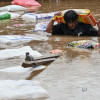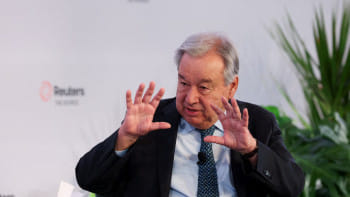Beyond the flames: Nepal’s search for a sovereign path

The Himalayas have always been a place of profound silence and deep truths. But in the autumn of 2025, that silence is shattered by the roar of a generation that could wait no longer. The images from Kathmandu are both electrifying and heartbreaking: a sea of young, determined faces illuminated by the flicker of a state's failing legitimacy. The resignation of Prime Minister KP Sharma Oli was a seismic event, a testament to the power of the people's will.
Yet, as the smoke clears over Singha Durbar, a crucial question emerges for Nepal and for all watching nations in the Global South: in a world of competing giants, can the righteous anger of a people be channelled into building a truly sovereign future, or does it risk being steered by other designs? The test for Nepal is not just to voice its rage, but to own its revolution.
To dismiss Nepal's unrest as a foreign concoction is to insult the intelligence and the agony of its youth. The fuel for this fire was laid down over years of profound neglect. Nepal's economy has become a cruel paradox: it is a factory that does not produce goods, but exiles. The issuance of over 839,266 exit permits in the last fiscal year further highlights the national crisis. This relentless exodus of its brightest and strongest, propping up a remittance economy that constitutes over 33 percent of GDP, is an admission of a state's failure to provide for its citizens. When a government's primary export is its own people, what remains is a powder keg of disillusionment, with youth unemployment acting as the fuse.
The state's decision to ban social media was not merely a misstep; it was an act of digital suffocation. For a generation that lives, works, and dreams online, this was the final, unforgivable severance. Their protest was organic, a raw, legitimate cry for a future that doesn't require a passport to be lived.
But righteous anger has a dangerous twin: orchestrated chaos. The evolution of the protests from mass dissent to systematic destruction follows a pattern that raises difficult questions. For instance, the burning of the Birgunj Customs Office, a vital economic artery, was not a mere act of passionate protest. It was a surgical strike on institutional state capacity.
The most alarming event was the assault on Dillibazar Jail. The escape of an estimated 15,000 inmates is not the work of enraged students; it is a tactical operation that demands planning, resources, and a specific intent to unleash anarchy and paralyse the state. This is the moment the script may have flipped—when a homegrown movement becomes a fertile ground for those who specialise in turning chaos into strategic advantage.
Why would external powers care about the fate of a small, landlocked nation? The answer lies in geography and the relentless logic of power. Nepal, perched between India and China, is the ultimate buffer state. For decades, it has navigated a delicate dance between its two colossal neighbours. But one project promises to shatter this balance: the China-Nepal trans-Himalayan railway.
This is not just a train line. As former Chinese envoys have stated, it is a "game-changer," designed to transform Nepal from a landlocked nation into a "land-linked" hub, integrated directly into China's Belt and Road Initiative. It represents nothing less than a fundamental reorientation of Nepal's economic and strategic destiny away from its historical dependencies. For any power invested in containing the rise of a multipolar Asia and maintaining its own primacy, this is an unacceptable prospect. A stable, confident Nepal building this railway is one thing; a Nepal in flames, its government toppled and its future uncertain, is quite another.
This is where the documented actions of external actors demand scrutiny, not as proof of conspiracy, but as a map of undeniable interest. The United States has a long and sophisticated history of influencing political transitions under the banner of "democracy promotion." The National Endowment for Democracy (NED), with its deep congressional funding and historical ties to intelligence agendas, has been a vehicle for this influence globally. The fact that several Nepali youth groups and NGOs at the forefront of the unrest have received NED funding is a data point that cannot be ignored.
The diplomatic choreography is equally telling. The 2023 Nepal visit of Victoria Nuland, a diplomat synonymous with hawkish interventionism in Ukraine and elsewhere, was a significant signal. The highly publicised meeting between the popular, anti-establishment Kathmandu Mayor, Balen Shah, and US Ambassador Dean Thompson was another. In the subtle language of geopolitics, these are not casual chats. They are alignments. They are efforts to co-opt the energy of dissent and channel it towards outcomes that serve a larger, offshore strategy.
The question for the Global South is not whether Nepali youth have a right to be angry. They do. The question is whether their authentic cry for justice is being amplified and weaponised to ensure the Himalayan railway never leaves the drawing board, to keep Nepal in a state of manageable instability, and to ensure the great game of control continues, just with new, digitally-native pawns.
Nepal's story is our story. It is a cautionary tale for Bangladesh, India, Pakistan, and every nation navigating the treacherous waters of 21st-century geopolitics. It teaches us that our domestic failures—our corruption, our inequality—are our greatest vulnerabilities, the open windows through which foreign influence flies in.
The path forward for Nepal, and for all of us, is not to reject the valid demands of the young. It is to build nations so resilient, so just, and so confident in their own sovereignty that they become immune to the whispered scripts of external actors. The dream of a peaceful, prosperous, and interconnected South Asia depends on it. The Himalayas have witnessed empires rise and fall. The hope now is that they will witness the rise of a Nepal that is not a trophy in a new Cold War, but a sovereign author of its own destiny, its future written in the hopeful, determined eyes of its youth, finally building at home.
Zakir Kibria is a Bangladeshi writer, policy analyst and entrepreneur based in Kathmandu. He can be reached at [email protected].
Views expressed in this article are the author's own.
Follow The Daily Star Opinion on Facebook for the latest opinions, commentaries and analyses by experts and professionals. To contribute your article or letter to The Daily Star Opinion, see our guidelines for submission.

 For all latest news, follow The Daily Star's Google News channel.
For all latest news, follow The Daily Star's Google News channel. 










Comments